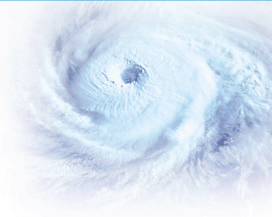
Typhoons are large storms equivalent to hurricanes in the Atlantic Ocean. These storms frequently hit Taiwan, usually between July and October, and are capable of inflicting serious damage, with heavy rains and winds that can exceed 183 kilometers per hour (or 114.5 miles per hour) in extreme cases.
Residents should always remain prepared for typhoons, particularly during summer months, by stocking emergency supplies in their homes. These should include a flashlight, batteries, candles, matches, first-aid kit, instant and canned foods, drinking water, and battery-operated radio. Tape and plastic sheeting to protect household items and windows are also advised. Other preventative measures should include maintaining clear drains in balconies and window boxes to prevent flooding, and checking for leaks.
To prepare for the imminent arrival of a typhoon it is best to fill a bathtub and/or sink with water (sealing stoppers with plastic to prevent leakage) for flushing toilets and other non-drinking purposes in the event of a water stoppage. Preparing extra ice cubes and turning refrigerators up to the highest setting will also help keep refrigerated food cool if there is a power outage.
When a typhoon is within 24 hours of hitting Taiwan (Condition 24), it is best to move furniture away from windows and roll up rugs. Ground-floor residents in flood-prone areas may want to place furniture legs in cans or on bricks.
Within 12 hours of a typhoon's arrival (Condition 12), it is advised to move cars and motorcycles away from areas that are vulnerable to flooding, high winds and flying debris. In the event that school/business closures are announced, it is strongly advised that residents return home immediately and remain there, as high winds, heavy rains and debris can block or flood roads and make driving very hazardous. In the event of strong winds, windows should also be taped in a criss-cross fashion, using heavy-duty packing or other tapes. It is best to leave one window on a side of the house/apartment away from the storm slightly open to prevent the creation of a vacuum during the storm.
During the storm, exercise caution around windows and keep curtains closed. If the power goes out, open the refrigerator as little as possible. A refrigerator will maintain its temperature for 24 to 48 hours if it is not opened. If power or water supplies are cut, do not tie up phone lines to make a report. Utility companies do monitor the situation closely and will make repairs as soon as possible. Remain indoors until the storm has completely passed. If the eye of the storm passes over, be aware that winds will suddenly die down, but just as suddenly pick up in full force from the opposite direction.
To receive regularly updated English information about typhoons, tune in to the English-language ICRT radio station (FM 100.1 or AM 576), which provides hourly updates and will announce any school and business closures. ICRT also provides fax-on-demand weather updates, including typhoon maps, by faxing (02) 2873-3236, ext. 102.
Another good source of information, including the latest satellite weather maps, is the Central Weather Bureau's website at: http://www.cwb.gov.tw (click onto English version). Local 24-hour TV news stations and CNN also provide good typhoon news updates in Chinese and English, respectively.

 Facebook
Facebook
 Twitter
Twitter
 LINE
LINE